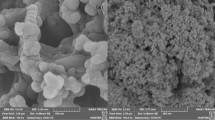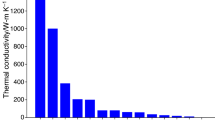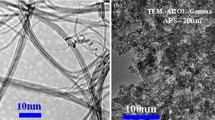Abstract
Although, titanium oxide (TiO2) has appropriate mechanical and chemical stability used in different applications, its thermal conductivity slightly increases with an increasing temperature and concentration compared with other metal oxides such as aluminum oxide (Al2O3). Thus, synthesized aluminum oxide nanoparticles were incorporated on the surfaces of titanium oxide in ultrasonication condition with purpose of thermophysical properties modification. The scanning electron microscopy and X-ray diffraction were used to investigate the structure and morphology of synthesized nanocomposite. The impact of variables (temperature, volume fraction and nanoparticle size) on the thermal conductivity and viscosity of prepared hybrid nanofluid was investigated using KD2Pro instrument and Brookfield DVII viscometer, respectively. Results showed a significant improvement of thermophysical properties of prepared hybrid nanofluid, compared to water or untreated titanium oxide–water. The results showed that three mentioned variables considerably affect the thermophysical properties of hybrid nanofluid; as an increasing volume fraction, reducing nanoparticle size and temperature led to an increasing viscosity while enhanced thermal conductivity was resulted from an increasing nanofluid volume fraction and temperature, and a decreasing nanoparticle size. This was confirmed using two computer-modeling approaches, which allow optimization of the thermophysical properties of hybrid nanofluid. Modifying Response Surface Methodology-Central Composite Design (RSM-CCD) estimated accurately the optimal conditions for thermal conductivity and viscosity. The best artificial neural network model was chosen based on its predictive accuracy for estimation of thermophysical properties; having seven neurons in hidden layer and minimum error, demonstrated the most accurate approach for modeling the considered task.















Similar content being viewed by others
Abbreviations
- T :
-
Temperature (° C)
- k :
-
Thermal conductivity W/m. K
- D :
-
Average crystal size (nm)
- μ :
-
Dynamic viscosity (kg/mS)Pa.s
- φ :
-
Volume fraction %v/v
- ρ :
-
Density(kg/m3)
- λ:
-
Wavelength
References
Hussein, A.M.; Bakar, R.A.; Kadirgama, K.; Sharma, K.V.: Experimental measurement of nanofluids thermal properties. Int. JAutomotive Mech. Eng. (2013). https://doi.org/10.15282/ijame.7.2012.5.0070
Yu, W.; France, D.M.; Routbort, J.L.; Choi, S.U.S.: Review and comparison of nanofluid thermal conductivity and heat transfer enhancements. Heat Transfer Eng. 29, 432–460 (2008)
Tyler, T.; Shenderova, O.; Cunningham, G.; Walsh, J.; Drobnik, J.; McGuire, G.: Thermal transport properties of diamond-based nanofluids and nanocomposites. Diam. Relat. Mater. 15, 2078–2081 (2006)
Das, S.K.; Choi, S.U.S.; Patel, H.E.: Heat transfer in nanofluids, a review. Heat Transfer Eng. 27(10), 3–19 (2006)
Liu, M.S.; Lin, M.C.C.; Huang, I.T.; Wang, C.C.: Enhancement of thermal conductivity with carbon nanotube for nanofluids. Int. Commun. Heat Mass Transfer 32, 1202–1210 (2005)
Choi, S.U.S.; Zhang, Z.G.; Keblinski, P.; Nalwa, H.S. (eds.): Nanofluids, in encyclopedia of nanoscience and nanotechnology, vol. 6, pp. 737–757. American Scientific Publishers, Los Angeles (2004)
Murshed, S.M.S.; Tan, S.H.; Nguyen, N.T.: Temperature dependence of interfacial properties and viscosity of nanofluids for droplet-based microfluidics. J. Phys. D Appl. Phys. 41(085502), 1–5 (2008)
Wong, K.V.; Kurma, T.: Transport properties of alumina nanofluids. Nanotechnology 19(345702), 8 (2008)
Wong, K.V.; Bonn, B.; Vu, S.; Samedi, S.: Study of nanofluid natural convection phenomena in rectangular enclosures, In: Proceedings of IMECE 2007, Nov. 2007, Seattle
Minkowycz, W.; et al.: Nanoparticle Heat Transfer and Fluid Flow. CRC Press, Boca Raton (2013)
Das, S.K.; Stephen, S.U.; Choi, W.Yu; Pradeep, T.: Nanofluids Science and Technology, p. 397. Wiley, New Jersey (2007)
Kakaç, S.; Pramuanjaroenkij, A.: Review of convective heat transfer enhancement with nanofluids. Int. J. Heat Mass Transf. (2009). https://doi.org/10.1016/j.ijheatmasstransfer.2009.02.006
Sundar, L.S.; Sharma, K.V.; Singh, Manoj K.; Sousa, A.C.M.: Hybrid nanofluids preparation, thermal properties, heat transfer and friction factor–a review. Renew. Sustain. Energy Rev. 68(P1), 185–198 (2017)
Choi, S.U.S.: Nanofluids: from vision to reality through research. J. Heat Transfer 131(3), 9 (2009)
Masuda, H.; Ebata, A.; Teramea, K.; Hishinuma, N.: Alteration of thermal conductivity and viscosity of liquid by dispersing ultra-fine particles. Netsu Bussei 4, 227–233 (1993)
Eastman, J.A.; Choi, U.S.; Li, S.; Thompson, L. J.; Lee, S: Enhanced thermal conductivity through the development of nanofluids. In: Komarneni, S., Parker, J. C., Wollenberger, H. J., (eds.)Nanophase and Nanocomposite Materials II. pp. 3–11. Materials Research Society, Pittsburg (1997)
Yu, W.H.; France, D.M.; Routbort, J.L.; Choi, S.U.S.: Review and comparison of nanofluid thermal conductivity and heat transfer enhancements. Heat Transfer Eng. 29, 432–460 (2009)
Eapen, J.; Rusconi, R.; Piazza, R.; Yip, S.: The classical nature of thermal conduction in nanofluids. J. Heat Transfer 132, 102402-1–102402-14 (2010)
Rusconi, R.; Rodari, E.; Piazza, R.: Optical measurements of the thermal properties of nanofluids. Appl. Phys. Lett. 89, 2619161–2619163 (2006)
Putnam, S.A.; Cahill, D.G.; Braun, P.V.: Thermal conductivity of nanoparticle suspensions. J. Appl. Phys. 99, 084308-1–084308-6 (2006)
Venerus, D.C.; Kabadi, M.S.; Lee, S.; Perez-Luna, V.: Study of thermal transport in nanoparticle suspensions using forced Rayleigh scattering. J. Appl. Phys. 100, 0943101–0943105 (2006)
Buongiorno, J.; Venerus, D.C.; Prabhat, N.: A benchmark study on the thermal conductivity of nanofluids. J. Appl. Phys. 106, 094312-1–094312-14 (2009)
Prasher, R.: Measurements of nanofluid viscosity and its implications for thermal applications. Appl. Phys. Lett. 89(13), 133108 (2006)
Chen, H.; Yulong, D.; Chunqing, T.: Rheological behaviour of nanofluids. New J. Phys. 9(10), 367 (2007)
Xie, H.; Yu, W.; Li, Y.; Chen, L.: Discussion on the thermal conductivity enhancement of nanofluids. Nanoscale Res. Lett. 6, 1–24 (2011)
Animasaun, I.L.: 47nm Alumina–water nanofluid flow within boundary layer formed on upper horizontal surface of paraboloid of revolution in the presence of quartic autocatalysis chemical reaction. Alex. Eng. J. 55, 2375–2389 (2016)
Animasaun, I.L.; Sandeep, N.: Buoyancy induced model for the flow of 36 nm alumina–water nanofluid along upper horizontal surface of a paraboloid of revolution with variable thermal conductivity and viscosity. Powder Technol. (2016). https://doi.org/10.1016/j.powtec.2016.07.02
Hemmat Esfe, M.; Esfandeh, S.; Saedodin, S.; Rostamian, H.: Experimental evaluation, sensitivity analyzation and ANN modeling of thermal conductivity of ZnO-MWCNT/EG-water hybrid nanofluid for engineering applications. Appl. Therm. Eng. 125(2017), 673–685 (2017). https://doi.org/10.1016/J.APPLTHERMALENG.2017.06.077
Moradikazerouni, A.; Hajizadeh, A.; Safaei, M.R.; Afrand, M.; Yarmand, H.; Zulkifli, N.W.B.M.: Assessment of thermal conductivity enhancement of nano-antifreeze containing single-walled carbon nanotubes: optimal artificial neural network and curve-fitting. Phys. A Stat. Mech. Appl. 521(2019), 138–145 (2019). https://doi.org/10.1016/j.physa.2019.01.051
Yarmand, H.; Afrand, M.; Safaei, M.R.; Zulkifli, N.W.B.M.; Qi, C.; Hajizadeh, A.: Evaluating the effect of temperature and concentration on the thermal conductivity of ZnO-TiO2/EG hybrid nanofluid using artificial neural network and curve fitting on experimental data. Phys. A Stat. Mech. Appl. 519(2018), 209–216 (2018). https://doi.org/10.1016/j.physa.2018.12.010
Nasirzadehroshenin, F.; Maddah, H.; Sakhaeinia, H.; Pourmozafari, A.: Investigation of exergy of double-pipe Heat exchanger using synthesized hybrid nanofluid developed by modeling. Int. J. Thermophys. 40, 87 (2019). https://doi.org/10.1007/s10765-019-2551-z
Manasrah, A.D.; Al-Mubaiyedh, U.A.; Laui, T.; Ben Mansour, R.; Al-Marri, M.J.; Almanassra, I.W.; Abdala, A.; Atieh, M.A.: Appl. Therm. Eng. 107, 1008–1018 (2016)
Chandraprabu, V.; Sankaranarayanan, G.; Iniyan, S.; Suresh, S.: Heat transfer enhancement characteristics of Al2O3/Water and CuO/Water nanofluids in a tube in tube condenser fitted with an air conditioning system—an experimental comparison. J. Therm. Sci. Eng. Appl. 6(041004), 1–5 (2014)
Venkateshan, T.; Eswaramoorthi, M.: A review on performance of heat exchangers with different configurations. Int. J. Res. Appl. Sci. Eng. Technol. 3, 2321–9653 (2015)
Jung, J.-Y.; Cho, C.; Lee, W.H.; Kang, Y.T.: Int. J. Heat Mass Transfer 54, 1728–1733 (2011)
Eastman, J.A.; Choi, S.; Li, S.; Yu, W.; Thompson, L.: Appl. A Phys. Lett. 78, 718–720 (2001)
Author information
Authors and Affiliations
Corresponding author
Rights and permissions
About this article
Cite this article
Nasirzadehroshenin, F., pourmozafari, A., Maddah, H. et al. Experimental and Theoretical Investigation of Thermophysical Properties of Synthesized Hybrid Nanofluid Developed by Modeling Approaches. Arab J Sci Eng 45, 7205–7218 (2020). https://doi.org/10.1007/s13369-020-04352-6
Received:
Accepted:
Published:
Issue Date:
DOI: https://doi.org/10.1007/s13369-020-04352-6




